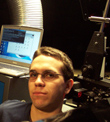|
|
This topic comprises 2 pages: 1 2
|
|
Author
|
Topic: Measuring Screen Luminance
|
Manny Knowles
"What are these things and WHY are they BLUE???"

Posts: 4247
From: Bloomington, IN, USA
Registered: Feb 2002
|
 posted 02-26-2002 04:40 AM
posted 02-26-2002 04:40 AM




Without spending thousands on the Minolta LS-100 meter or the USL outfit, how can I measure screen luminance?I remember reading how to do it with a regular spot meter, but I can't remember the conversion techniques. How are you measuring screen luminance without breaking the bank? ------------------
And, hey! Let's be careful out there. ~Manny.
| IP: Logged
|
|
|
|
|
|
Steve Kraus
Film God

Posts: 4094
From: Chicago, IL, USA
Registered: May 2000
|
 posted 02-26-2002 09:00 AM
posted 02-26-2002 09:00 AM



I think it would be easier (and perhaps more accurate) to simply use the camera's exposure system to read an existing screen of proper brightness and then compare that with the screen in question. Using the same camera would equalize any differences the shutter effect would have although it would be interesting to see if it would be transferable. In other words, at x ISO/ASA setting, y f-stop, z-shutter speed, when the exposure system indicates proper exposure you're at 16 fL. Sufficiently long lens and or close proximity to make it more of a spot meter. How about this: Long cardboard tube (like from gift wrap), spray paint interior flat black, large solar cell (Radio-Shack) at one end, connected to a cheap meter movement via suitable adjustment potentiometer (perhaps a resistor across the meter as well). Maybe some sort of aiming device. Calibrate to known standard of 16 fL, perhaps some other values higher or lower. The long tube is so as to get a spot reading from a suitably small area of the screen. Actually only the outer end needs the black paint to cut light from parts of the screen not being measured; further down the tube any cross reflection will be light from the area under study and shouldn't matter.
| IP: Logged
|
|
|
|
|
|
|
|
|
|
|
|
|
|
|
|
|
|
|
|
|
|
|
|
|
|
All times are Central (GMT -6:00)
|
This topic comprises 2 pages: 1 2
|
Powered by Infopop Corporation
UBB.classicTM
6.3.1.2
The Film-Tech Forums are designed for various members related to the cinema industry to express their opinions, viewpoints and testimonials on various products, services and events based upon speculation, personal knowledge and factual information through use, therefore all views represented here allow no liability upon the publishers of this web site and the owners of said views assume no liability for any ill will resulting from these postings. The posts made here are for educational as well as entertainment purposes and as such anyone viewing this portion of the website must accept these views as statements of the author of that opinion
and agrees to release the authors from any and all liability.
|

 Home
Home
 Products
Products
 Store
Store
 Forum
Forum
 Warehouse
Warehouse
 Contact Us
Contact Us




 Printer-friendly view of this topic
Printer-friendly view of this topic










![[Frown]](frown.gif) .)
.)





